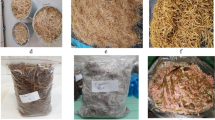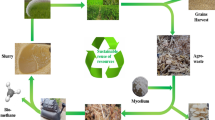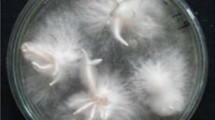Abstract
The research evaluated the changes in degradability of some agro-forest wastes such as poplar sawdust, wheat straw, date palm wastes, and sugarcane bagasse during the cultivation of T. versicolor (turkey tail) to better understand the nutritional needs, evaluation of chemical and lignocellulosic changes of substrates, and physicochemical traits of mushroom. In addition, the possibility of spent wastes as soil amendment was evaluated. The substrates were studied for pH, EC, moisture, ash, cellulose, hemicellulose, lignin, macro-(C, N, P, K, Ca, and Mg), and microelements (Cu, Zn, Fe, and Mn), at nine substrate formulations during growing stages. Moreover, the effect of agro-wastes on mushroom fresh and dry weight, spawn run time, pinhead formation time, precocity time, some minerals (N, K, and Ca), and total polysaccharides was assessed. Among the nine formulations, the S1 (80% poplar sawdust + 20% wheat straw) exhibited maximum quantitative and qualitative yield. No relationship was found between the turkey tail yield and the nutritional composition or lignocellulosic account of the growing substrates. This indicates that the turkey tail mushroom needs moderate nutrition. In addition, in spent substrates (SS) the macro-(N, P, K, and Mg) and microelements (Zn and Fe) content was generally higher than initial substrates (IS), but carbon (C) content, lignocellulosic composition, and pH reduced in all SSs. The results suggest that the tested isolate has a suitable bioconversion capability and can be used to make agro-wastes to soil fertilizer. Furthermore, S1 substrate may be recommended as an appropriate substrate for T. versicolor cultivation.

Similar content being viewed by others
References
Janjušević L, Karaman M, Šibul F, Tommonaro G, Iodice C, Jakovljević D, Pejin B (2017) The lignicolous fungus Trametes versicolor (L.) Lloyd: a promising natural source of antiradical and AChE inhibitory agents. J Enzyme Inhib Med Chem 32(1), 355–362.
Thatoi H, Singdevsachan SK, Patra JK (2018) Prebiotics and their production from unconventional raw materials (Mushrooms). In: Grumezescu AM, Holban AM (eds) Therapeutic, Probiotic, and Unconventional Foods. Academic Press, Cambridge. pp 79–99. https://doi.org/10.1016/B978-0-12-814625-5.00005-4.
Bains A, Chawla P (2020) In vitro bioactivity, antimicrobial and anti-inflammatory efficacy of modified solvent evaporation assisted Trametes versicolor extract. 3 Biotech 10(9):1–11. https://doi.org/10.1007/s13205-020-02397-w
Habtemariam S (2020) Trametes versicolor (Synn. Coriolus versicolor) Polysaccharides in Cancer Therapy: Targets and Efficacy. Biomedicines. 8(5):135. https://doi.org/10.3390/biomedicines8050135
Atila F (2020) Comparative study on the mycelial growth and yield of Ganoderma lucidum (Curt: Fr.) Karst. on different lignocellulosic wastes. Acta Ecol Sin 40(2):153–157. https://doi.org/10.1016/j.chnaes.2018.11.007
Sanderson K (2011) Lignocellulose: a chewy problem. Nature 474:12–14. https://doi.org/10.1038/474S012a
Oyetayo VO, Ariyo OO (2013) Micro and macronutrient properties of Pleurotus ostreatus (Jacq: Fries) cultivated on different wood substrates. Jordan J Biol Sci 6(3):223–226
Lin Q, Long L, Wu L, Zhang F, Wu S, Zhang W, Sun X (2017) Evaluation of different agricultural wastes for the production of fruiting bodies and bioactive compounds by medicinal mushroom Cordyceps militaris. J Sci Food Agric 97:3476–3480. https://doi.org/10.1002/jsfa.8097
Bellettini MB, Fiorda FA, Maieves HA, Teixeira GL, Ávila S, Hornung PS, Júnior AM, Ribani RH (2019) Factors affecting mushroom Pleurotus spp. Saudi J Biol Sci 26:633–646. https://doi.org/10.1016/j.sjbs.2016.12.005
Atila F, Tuzel Y, Fernández JA, Cano AF, Sen F (2018) The effect of some agro–industrial wastes on yield, nutritional characteristics and antioxidant activities of Hericium erinaceus isolates. Sci Hortic 238:246–254. https://doi.org/10.1016/j.scienta.2018.04.049
Atila F (2019) Lignocellulosic and proximate based compositional changes in substrates during cultivation of Hericium erinaceus mushroom. Sci Hortic 258:108–179. https://doi.org/10.1016/j.scienta.2019.108779
Owaid MN, Abed IA, Al-Saeedi SSS (2017) Applicable properties of the bio-fertilizer spent mushroom substrate in organic systems as a byproduct from the cultivation of Pleurotus spp. Inf Process Agric 4(1):78–82. https://doi.org/10.1016/j.inpa.2017.01.001
Sardar H, Ali MA, Anjum MA, Nawaz F, Hussain S, Naz S, Karimi SM (2017) Agro-industrial residues influence mineral elements accumulation and nutritional composition of king oyster mushroom (Pleurotus eryngii). Sci Hortic 225:327–334. https://doi.org/10.1016/j.scienta.2017.07.010
Peksen A, Yakupoglu G, Yakupoglu T, Gulser C, Ozturk E, Ozdemir N (2011) Changes in chemical compositions of substrates before and after Ganoderma lucidum cultivation. World J Microbiol Biotechnol 27:637–642. https://doi.org/10.1007/s11274-010-0500-x
Rezaeian S, Pourianfar H (2017) A comparative study on bioconversion of different agro wastes by wild and cultivated strains of Flammulina velutipes. Waste Biomass Valorization 8:2631–2642. https://doi.org/10.1007/s12649-016-9698-7
Kumari R (2017) In-Vitro Propagation of Ganoderma Lucidum – A Medicinal Mushroom in Different Culture Medium. Int J Innov Res Sci Eng Technol 2(4):294–297
AOAC (1995) (Association of Official Analytical Chemist), in: S.ed. Williams (Ed.), Official Methods of Analysis, 16th edition A.O.A.C, Washington, USA, pp. 101–102.
Van Soest PJ, Robertson JB, Lewis BA (1991) Methods for dietary fiber neutral detergent fiber and non-starch polysaccharide in relation to animal nutrition. J Dairy Sci 74:3583–3597. https://doi.org/10.3168/jds.S0022-0302(91)78551-2
Jones JB Jr, Case VW (1990) Sampling, handling, and analyzing plant tissue samples. Soil testing and plant analysis 3:389–427. https://doi.org/10.2136/sssabookser3.3ed.c15
Dubois M, Gilles KA, Hamilton JK, Rebers PT, Smith F (1959) Colorimetric method for determination of sugars and related substances. Anal Chem 28(3):350–356. https://doi.org/10.1021/ac60111a017
Atila F (2017) Evaluation of suitability of various agro-wastes for productivity of Pleurotus djamor, Pleurotus citrinopileatus and Pleurotus eryngii Mushrooms. J Exp Agric Int 17(5):1–11. https://doi.org/10.9734/JEAI/2017/36346
Zervakis G, Philippoussis A, Ioannidou S, Diamantopoulou P (2001) Mycelium growth kinetics and optimal temperature conditions for the cultivation of edible mushroom species on lignocellulosic substrates. Folia Microbiol 46(3):231. https://doi.org/10.1007/BF02818539
Locci E, Laconi S, Pompei R, Scano P, Lai A, Marincola FC (2008) Wheat bran biodegradation by Pleurotus ostreatus: a solid-state Carbon-13 NMR study. Bioresour Technol 99:4279–4284. https://doi.org/10.1016/j.biortech.2007.08.048
Singh M, Pandey V, Srivastava A, Viswakarma S (2011) Biodegradation of Brassica haulms by white rot fungus Pleurotus eryngii. Cell Mol Biol (Noisy-le-grand) 57:47–55.
Harith N, Abdullah N, Sabaratnam V (2014) Cultivation of Flammulina velutipesmushroom using various agro-residues as a fruiting substrate. Pesqu Agropecu Bras 49:181–188. https://doi.org/10.1590/S0100-204X2014000300004
Obodai M, Cleland-Okine J, Vowotor KA (2003) Comparative study on the growth and yield of Pleurotus ostreatus mushroom on different lignocellulosic by-products. J Ind Microbiol Biotechnol 30(3):146–149. https://doi.org/10.1007/s10295-002-0021-1
Philippoussis AN (2009) 'Production of mushrooms using agro-industrial residues as substrates.' in, Biotechnology for agro-industrial residues utilisation (Springer). https://doi.org/10.1007/978-1-4020-9942-7_9
Kumar V, Valadez-Blanco R, Kumar P, Singh J, Kumar P (2020) Effects of treated sugar mill effluent and rice straw on substrate properties under milky mushroom (Calocybe indica P&C) production: Nutrient utilization and growth kinetics studies. Environ Technol Innov 19:101041. https://doi.org/10.1016/j.eti.2020.101041
Gabriel J, Švec K, Kolihová D, Tlustoš P, Száková J (2016) Translocation of mercury from substrate to fruit bodies of Panellus stipticus, Psilocybe cubensis, Schizophyllum commune and Stropharia rugosoannulata on oat flakes. Ecotoxicol Environ Saf 125:184–189. https://doi.org/10.1016/j.ecoenv.2015.12.009
Koutrotsios G, Larou E, Mountzouris KC, Zervakis GI (2016) Detoxification of olive mill wastewater and bioconversion of olive crop residues into high-value-added biomass by the choice edible mushroom Hericium erinaceus. Appl Biochem Biotechnol 180:195–209. https://doi.org/10.1007/s12010-016-2093-9
Acknowledgements
The present study was conducted with the financial support of University of Zabol under Grant No. UOZ-GR-9618-92. We acknowledge University of Zabol for its financial support of this research.
Author information
Authors and Affiliations
Contributions
DR designed the study and supervised the main ideas. BAJ carried out the experiment and collected the data. ASK helped in biochemical analysis of substrates and mushroom samples. MP contributed to spawn preparation and substrate preparation. YF wrote the manuscript and analyzed the data. All authors helped to shape the research, analysis, and manuscript.
Corresponding author
Ethics declarations
Conflict of interest
The authors declare that they have no conflict of interest.
Additional information
Publisher's Note
Springer Nature remains neutral with regard to jurisdictional claims in published maps and institutional affiliations.
Significance Statement Various types of agro-forest wastes can be used for high value-added products such as medicinal mushrooms. As far as we know, the cultivation and bioconversion of Iranian isolate of Trametes versicolor have not been comprehensively evaluated. This study is intended to show how lignocellulosic waste from industrial-scale activities can be used as an ingredient in substrates for the cultivation of medicinal mushrooms. This study was conducted to understand the nutrient needs of the fungus and bioconversion process under inoculation with this isolate regard to exploiting spent substrates (after mushroom harvesting) as a soil fertilizer.
Rights and permissions
About this article
Cite this article
Ramezan, D., Alizade Jahan Abadi, B., Samzade Kermani, A. et al. Cultivation of Turkey Tail Mushroom (Trametes versicolor) on Lignocellulosic Wastes and Evaluation of Substrate Bioconversion. Proc. Natl. Acad. Sci., India, Sect. B Biol. Sci. 91, 777–787 (2021). https://doi.org/10.1007/s40011-021-01269-4
Received:
Revised:
Accepted:
Published:
Issue Date:
DOI: https://doi.org/10.1007/s40011-021-01269-4




